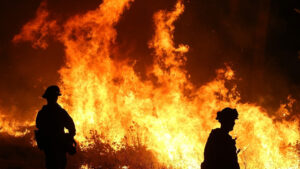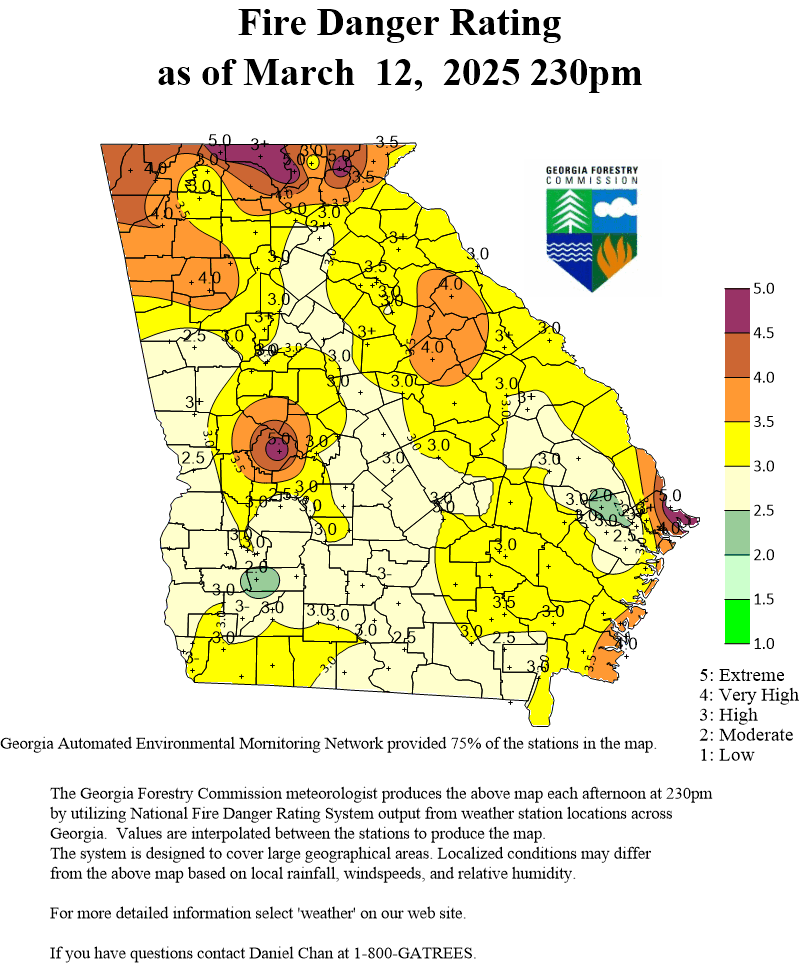
Heather N. Kolich, ANR Agent, UGA Extension Forsyth County
We tend to think of hazardous weather in terms of wind, snow, ice, rain, and floods. Dry weather can cause drought, which is bad news for lawns, crops, and occasionally waterway navigation. But dry weather can also set up the conditions for wildfires. This is why the weather app on my phone has sent a National Oceanic and Atmospheric Agency (NOAA) Special Weather Statement several times a day for two straight weeks.

After our big rain event that produced over 4 inches of rain between February 12 and 13, 2025, in our area, most of the state became dry. On March 3, 2025, the Georgia Forestry Commission (GFC) released a special report on wildland fires. Firefighters had battled nearly 500 wildfires that had burned over 6,000 acres of forest lands across the state.
This is just the beginning of the wildfire season, which runs from February through May in Georgia. On average, Georgia experiences over 2,300 wildfires each year. Weather creates the conditions for wildfires, and human activities, such as burning debris or tossing a cigarette, often provide the spark.
In a news release dated March 3, 2025, Georgia Forestry Commission Protection Chief Thomas Barrett stated, “The number one cause of these fires is escaped debris burning.”
Barrett listed other sources of wildfire ignition, including backyard leaf piles, grills, campfires, hot machinery, and cigarettes. In addition to burning timber and forest lands, wildfires destroy buildings and vehicles and cause death.
The conditions that create fire hazards are low humidity, wind and wind gusts, and dry fuels, such as dead leaves, dry grasses, and branches. Temperature and drought levels are also factors.
While Georgia no longer requires people to obtain a burn permit before burning hand-piled natural vegetation or yard debris comprised of leaves and limbs, GFC advises burners to follow safety practices with any outdoor burning. These include carefully planning the outdoor, or open, burn, starting with weather awareness and a check of the fire weather forecast on Georgia Forestry Commission Fire Weather System.

If the weather conditions are safe for outdoor burning, follow the S-S-T-A-R formula when setting up your burn:
- S – Space: ensure there are at least 25 feet between your fire and any woodlands
- S – Space: ensure there are at least 50 feet between your fire and any structures
- T – Time: only burn during daylight hours, from sunrise to sunset
- A – Attendance: always stay on-site until the fire is extinguished
- R – Reasonable precautions: have on-hand the tools and measures needed to prevent the fire from escaping. These include:
- A continuous, pressurized water source, such as a water hose attached to a functioning spigot, that extends to the fire and is ready to use
- A barrier to contain the fire, such as bare soil, a burn barrel, or a circle made of rocks or bricks around the fire
- Hand tools such as rakes, shovels, and hoes that can be used to contain the fire
We can track wildfire and smoke activity around the state through GFC’s Public Viewer. This interactive map shows where fires have been reported and whether they are active, controlled, or “mopped up.” It also has an air quality index monitor.
To help protect air quality, the Georgia Environmental Protection Department imposes a summer Open Burn Ban on 54 counties each year from May 1 through September 30. Metro Atlanta and surrounding counties are included in the summer burning ban. For more information, visit the Environmental Protection Division.